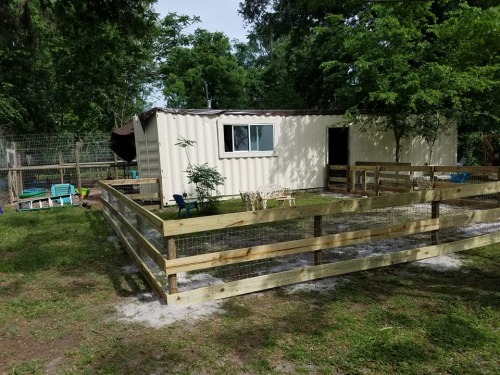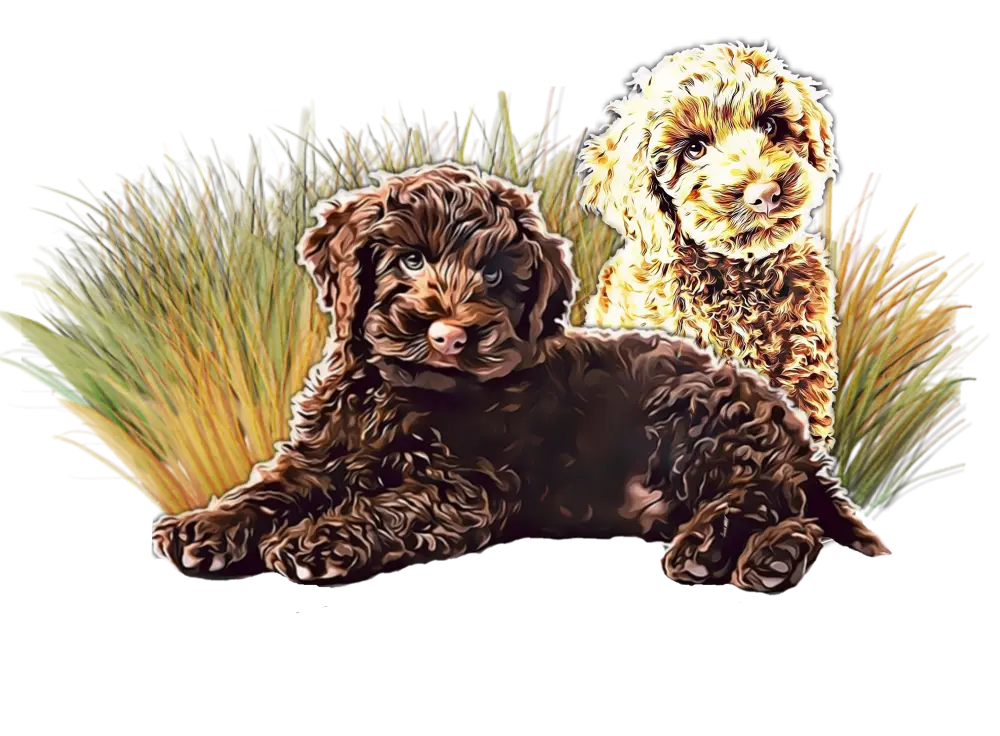No products in the cart.

Our indoor kennel areas are purposefully designed to be 3.5 feet by 4 feet wide, which is the ideal size for our mama dogs and her puppies to be comfortable and safe while not being so large that pups want to go potty inside.
All of our puppies follow their mothers through the doggy door to the farthest space of their 25-foot by 25-foot play yard to go potty.
Because the pup is already used to going potty outside, this setup makes potty training easier when they go home to their new families.
From there on, it is your job to teach the pup how to let you know he needs to potty, as well as where you want him to go.
If you will follow the basic concept below, potty training can be completed within a week or two.
All puppies respond well to positive training, be it treats or just an “Atah Boy”, when they do what you want. I firmly believe they will learn faster by receiving praise than by any other method. They all want to please you, and it is your job to patiently and lovingly teach them what you expect of them!

Potty Training:
I use and highly recommend using a crate for potty training, among other things. I use schedule feeding a new pup until they are completely potty trained. I recommend feeding 2 or 3 times a day, based on your schedule, though consistency is always best. The puppy will feel safe and secure knowing what and when to expect food et.
I fill the pup’s food bowl full and offer it to him for 20 minutes, 2 or 3 times a day, allowing him to eat all he wants in that time. I then put the food away and pick the puppy up and take him outside to the location that you have chosen for him to go potty. I give him 5 or so minutes to go potty, and if he goes, I make a HUGE BIG DEAL about what a good puppy is and really praise him so he knows that is what you wanted.
If he doesn’t go potty right away, I pick him up and hold him, or if I cannot keep my eyes on him, I put him in his crate, and then in about 5 or so minutes, I take him back out to go potty, and if he doesn’t go, I again crate or hold him. I do this until he finally goes potty outside. Once he does go potty you can allow him to run free inside, though supervised. I always keep my pups very close to me or in eyeshot to see if he is showing any signs of needing to go out. He may start sniffing or walk in circles, which means he is looking for a potty spot. The main point is to not let him run free out of your site so he cannot have an accident. The rule of thumb to remember is with a little pup it is always “FOOD IN and FOOD OUT” usually within 10 to 15 minutes of eating, so if you schedule feed you have control of when he goes potty for the most part. I use this method until he is completely potty trained, usually within a week or two. Once he is potty trained, you can free-feed him, and he will hold it until he is let out.
Another very important thing to remember is to use a divider in your crate so you can keep his crate only big enough to stand up, turn around and sleep. Any bigger than that he may go potty inside the crate. Pups do not like to go potty where they sleep, so if you keep it small enough to sleep only they will be less likely to have accidents in their crate.
Young pups usually need to be taken out in the middle of the night to go potty, they will usually let you know by either barking or whining.
It is hard for them to hold it all night at a young age, but the older they get the longer they can hold it and will be able to wait until morning.
I try to make the last meal of the day early enough that he goes to potty long before bedtime and then I take him out again just before bedtime. This way he may actually be able to hold it all night and I might get lucky and be able to sleep all night, grin!
If he doesn’t go potty right away, I pick him up and hold him, or if I cannot keep my eyes on him, I put him in his crate, and then in about 5 or so minutes, I take him back out to go potty, and if he doesn’t go, I again crate or hold him. I do this until he finally goes potty outside. Once he does go potty you can allow him to run free inside, though supervised. I always keep my pups very close to me or in eyeshot to see if he is showing any signs of needing to go out. He may start sniffing or walk in circles, which means he is looking for a potty spot. The main point is to not let him run free out of your site so he cannot have an accident. The rule of thumb to remember is with a little pup it is always “FOOD IN and FOOD OUT” usually within 10 to 15 minutes of eating, so if you schedule feed you have control of when he goes potty for the most part. I use this method until he is completely potty trained, usually within a week or two. Once he is potty trained, you can free-feed him, and he will hold it until he is let out.
Another very important thing to remember is to use a divider in your crate so you can keep his crate only big enough to stand up, turn around and sleep. Any bigger than that he may go potty inside the crate. Pups do not like to go potty where they sleep, so if you keep it small enough to sleep only they will be less likely to have accidents in their crate.
Young pups usually need to be taken out in the middle of the night to go potty, they will usually let you know by either barking or whining.
It is hard for them to hold it all night at a young age, but the older they get the longer they can hold it and will be able to wait until morning.
I try to make the last meal of the day early enough that he goes to potty long before bedtime and then I take him out again just before bedtime. This way he may actually be able to hold it all night and I might get lucky and be able to sleep all night, grin!
If you stick to this sometimes strict schedule, he’ll be potty trained in a week or so, saving you and your pup hours of frustration and clean-up!
After the pup is completely potty trained, you can remove the divider from the crate and use the crate as his own special place.
Dogs are Den Animals and love having their own place to sleep and hang out away from the world. His crate should always be a positive and safe place for him; he will grow to love it.
Another thing to keep in mind is that the puppy has just left the only home and family they have ever known. They have never been in a crate all by themselves, so at night they will cry to find their family. If it is possible for the first week or so, keep his crate in your room so he won’t feel so lonely and scared. He will fuss for a day or two but eventually figure out that you will let him out every morning and will get used to his new routine. He will cry to go potty in the middle of the night AND let you know he is scared and lonely. Once you know he no longer needs to go potty, you can just tap his cage every once in a while when he cries to let him know he is not alone and that it is nighty night time. NEVER let him out for playtime or anything else except potty in the middle of the night or when he cries; otherwise, he will learn that if he cries long enough, he will get to get out to play and will never learn his new routine. Also, in the middle of the night, when you take him out to go potty, always carry him in and out so he learns that getting out of the crate in the middle of the night is only for potty time, not playtime.
Another idea for families that are home and able:
To speed up the potty training process, I put a long leash on the puppy and tied the other end of the leash to my hip. This prevents me from getting distracted and missing his signs of needing to go to the potty, such as sniffing and turning in circles looking for a potty spot. His pull on the leash looking for a potty spot brings my attention to the fact that he needs to be taken outside to go potty.
I also take them outside to give them a chance to potty as often as possible to help them learn where the potty spot is. Every accident in the house is our fault for not keeping a close eye out for his signs of needing to go potty, which is why the leash idea works so well. NEVER fuss at a pup for having an accident; they are just babies learning, and it is our job to teach them with love and lots of patience!




